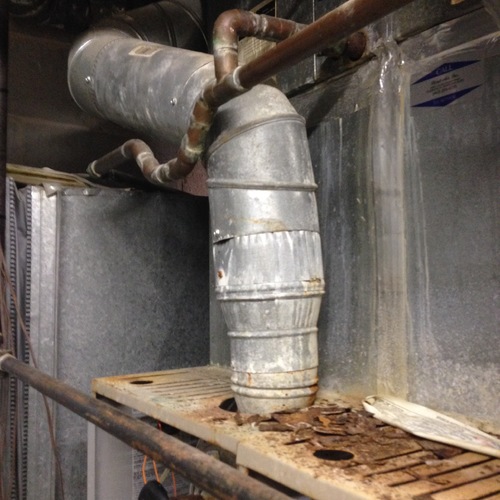Image Credit: Energy Vanguard This schematic shows the ducts laid out to provide separately-controlled heating and cooling to three zones in the house.
Image Credit: Energy Vanguard
Last year I wrote five articles in a series on duct design and ever since, I keep getting requests to continue it. Here’s a link to the first article in the series so you can go back and read them first if you’d like.
On GBA, I also published a revised version of the one on total effective length.
I’ll do a quick recap by saying that the focus in those first articles was the physics of air flow that went into determining how big the ducts need to be. We looked at the pressure from the blower that moves the air, the various pressure drops, and how total effective length is a measure of pressure drops, then used that information to calculate friction rate, which determines the duct sizes.
Getting our heads out of the ducts
Now let’s crank the series back up with a look at the bigger picture. One of the main points in the earlier articles was that sizing depends on the total effective length of the most restrictive run in the duct system. The equivalent lengths of the fittings matter more than the straight runs of well-installed duct (hardpipe or flex), so you’ve got to choose your fittings well to reduce the pressure drops.
The layout of the system determines what fittings you need and thus the total effective length. When we’re working on a duct design, we consider a number of factors that affect the layout: the client’s preferences, location of the air handler, framing issues, zoning, and location of the vents.
I’ll look at some of the other issues in future articles, but today I’m going to focus on zoning.
Should you zone the house?
This is a question you can address when you look at the house plans but you can’t answer it fully until you’ve done the heating and cooling load calculation. ACCA’s Manual J (the book, not just the protocol) has a nice section called “Procedure for Evaluating Zoning Requirements” (section 11-21 in my copy) that can be helpful if you’re trying to figure out if you should zone and how to do it. The procedure includes five steps:
1. Evaluate the architectural features. Of course the house design is the first thing to look for. Because warm air rises, for example, you’re going to want separate zones for separate floors. Manual J lists twelve factors that help you determine the need for zoning:
The basic idea here is to look for parts of the house that might have significantly higher or lower loads than other parts. In addition to separate zones for separate floors, another common example is putting bedrooms and common areas in separate zones.
The schematic reproduced as Image #2 (below) is a house we divided into three zones. The master suite is on the left, the common areas in the middle, and the other bedrooms on the right.
2. Evaluate time-of-day load patterns. The zones in that design below also factor in time-of-day patterns. The common areas are used mainly during the day, while the master suite and bedrooms are used more in the evenings, night, and mornings. Another consideration for time of day is the amount of solar gain a room or zone gets from the windows and skylights.
3. Evaluate air flow ratios. Balance is a good thing. If you’re using the same ducts for heating and cooling, it’s nice when you end up with ducts that deliver the right amount of heating in winter and the right amount of cooling in summer. One way to do that is by looking at the ratio of cooling air flow to heating air flow for each room in the zone. Here’s the guidance on that from Manual J:
Ideally, the C/H ratios of all rooms in a zone are within 15 percent of the C/H ratio of the room that has the zone thermostat.
What if you have a room that’s outside the 15% recommendation for any zone you could put it in? If there’s still time to make changes to the house design, you could try adjusting the insulation, window shading, or glazing area to get the C/H ratio closer. If you can’t do anything to change the ratio, it may come down to the occupants having to make seasonal adjustments to the supply vent louvers.
4. Evaluate room-to-room openings. The more open the rooms are to other rooms in a zone, the more resilient the zone will be to imbalances in loads, time-of-day patterns, and air flow ratios.
5. Finalize the zoning plan. Take stock of all the things above to figure out the best way to divide the house into zones. The goal is to create zones that lessen any imbalances in heating and cooling the rooms in that zone.
The two types of zoning
The term “zoning” can be confusing because it’s used two different ways. What I’ve been discussing up to this point is dividing a house into separate zones, each of which will have its own thermostat. But sometimes that term refers to setting up a single system to deliver heating and cooling to multiple zones. It’s usually clear from the context what’s meant when you see the word.
In the schematic below, the house has three zones served by a single system that’s zoned. When you’re designing a duct system that matters a lot. If the three zones were served by three systems, we’d have three air handlers, probably located near the zones they serve. That should result in lower total effective lengths. With a zoned system serving the three zones, you have more total effective length and it’s not so much because of the greater distances as it is the increased number of fittings. To get all the way across the house, you have turn the air more. Plus, you have the zone dampers and their pressure drops/equivalent lengths.
Zoning issues
Here are some things to keep in mind regarding zoning:
- One zone for a whole house? It’s certainly possible to do a whole house on one zone. You usually end up with less balance in the heating and cooling but if the house doesn’t have any large loads from windows and the house isn’t too big, a single zone can work fine. The more disparities you have in the room-to-room loads and the more spread-out the house is, the more the house might benefit by zoning.
- Single room zoning. Of course, the ultimate zoning would be to have each room as its own zone. In houses without cooling systems, you get close to that sometimes with the old radiators in each room, if they’re individually controlled. With heating and cooling, the closest we can come is to use ductless minisplit heat pumps but they don’t come in small enough sizes (or low enough cost) to be used in ever single room.
- Small zones with minisplit heat pumps. The next step up would be ducted minisplit heat pumps, which let you create small zones that include only a few rooms each. We’ve done ducted minisplit designs where a house the size of the one below might have five or six zones instead of just three. Because minisplits come in smaller sizes, each zone in the house would have its own system.
- Some rooms need separate equipment. If you plan to heat or cool a garage, it must be done with a separate system. The same goes for indoor swimming pools.
- Zoning an HVAC system. With conventional equipment, you divide the air up with separate trunk lines that carry the air to each zone. A zone damper opens and closes based on what the thermostat tells it to do. But what happens if just one of three zones is calling for air? With a fixed-capacity, fixed-speed system, you’ve got to find a place to send the excess air. One common solution has been to install a bypass duct, which is generally a bad idea. Better would be to use a variable-capacity system with a variable-speed blower when you do zoning. That way the air flow adjusts to what’s needed (within the limits of the system chosen).
So now you have a little education on zoning a house and zoning an HVAC system. The ACCA manuals have a lot of information on this topic if you want to go deeper, but the basic idea is that you look at the features of the house to determine if you need to create separate zones. Then you figure out whether to heat and cool those zones with separate pieces of equipment or with one zoned system.
Allison Bailes of Decatur, Georgia, is a speaker, writer, building science consultant, and the author of the Energy Vanguard Blog. You can follow him on Twitter at @EnergyVanguard.
Weekly Newsletter
Get building science and energy efficiency advice, plus special offers, in your inbox.
















7 Comments
I'd add another factor: insulation and/or thermal mass. I worked on a community building a few years ago with 3 zones on two heat pumps. It was so well insulated that just a few people in the room with the thermostat would negatively affect the other rooms in the zone. I think that building would have benefited from more zones because the occupancy load was a relatively large proportion of the total for some rooms. Conversely, my 1930s masonry house has enough mass (and no wall insulation) to mask some shortcomings of the retrofitted A/C ductwork and maybe to a lesser extent, the radiator heat.
Let's see, do hotels use ducts and zoning? Generally not. Well insulated houses don't need them either.
Every hotel room I've been in has been zoned with its own thermostat.
Well insulated doesn't mean that the south facing room doesn't have a wildly varying amount of required heat/AC in proportion to a north bedroom, causing significant discomfort. Please post data showing otherwise.
You didn’t mention fan coil units?
+1 on the comfort advantages of a hydronic system with as many thermostats/zones as you want.
> "Ideally, the C/H ratios of all rooms in a zone are within 15 percent of the C/H ratio of the room that has the zone thermostat."
So what happens when it's 0F outside and heat delivery to a closed door room is 15% too low (because it was balanced for cooling)? The room will be around 10F too hot or cold. OK, balance for heating and it might be 4F off with AC use (more with other causes of variation). That's still too much.
I suggest that except for extreme cases (like 200+%), over-sizing of modulating equipment is an insignificant comfort issue in comparison to lack of zoning. But lots of focus on the former, little on the latter.
I went through some math - short answer, without zoning, it's easy to come up with things that cause significant temperature discomfort.
The worst one is wind. Take a 3 ACH house on a windy day (where ACH-natural can equal ACH@50). Assume that most of the infiltration occurs on the windward side room(s) and calculate the change in load. Wind could add a temporary load of 20,000 btu/hr to a single room! Solar gain is another issue.
> A zone damper opens and closes
A common mistake. If one only needs a 20% adjustment, then the zone damper should move from 100% open to 80% open - never fully closing and never causing enough shift in total airflow to cause flow problems.
Hydronic + fan coils is somewhat more expensive - but is anything else workable if one wants to always meet ACCA comfort recommendations?
Great point I haven’t considered. I’m building a passive house and have settled on fan coil units for zoning.
It’s hard finding a low load concealed fan coil unit though or a good looking fan coil unit that’s not concealed.
I’ll likely use chiltrix even though they are small company and durability of their product is difficult to verify. There doesn’t seem to be a lot of options in the US (sigh).
Log in or create an account to post a comment.
Sign up Log in